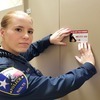The face of COVID-19
At 12:01 a.m. Friday, May 1, Gov. Greg Abbott allowed Texas’ stay-at-home order -- in response to the Coronavirus (COVID-19) -- to expire as phase 1 of the plan to reopen Texas began.
Retailers, movie theaters and restaurants can now allow the general public through their doors, but only up to a 25 percent occupancy rate.
Churches were also allowed to open for regular services.
Four days after the state began opening restaurants and retail locations, Abbott announced salons, barbershops and cosmetology services could open on Friday, May 8, with restrictions.
Plans to open gyms, non-essential warehouses and office buildings are still set to begin with phase 2 on May 18, again with restrictions. As phase 1 ends and phase 2 begins on May 18 -- if COVID-19 has slowed its spread -- retail stores and other businesses may be able to increase occupancy to 50 percent.
However, Abbott stated in his April 30 press conference people need to continue practicing social distancing and those over 65 or considered at-risk should continue to stay home.
Positive cases of COVID-19 have been reported in 216 of Texas’ 254 counties and the Texas Department of State Health Services reported that as the state was opening back up, the number of cases increased to more than 33,000, including 906 deaths. Cherokee County and neighboring counties of Smith, Angelina and Nacogdoches have all reported additional positive cases since May 1.
As of Monday, May 11, the number of confirmed cases reported on the DSHS website has increased to 38,869 with 16,759 active cases and 1,626 individuals currently hospitalized. The number of fatalities related to COVID-19 is listed as 1,088. The county reporting the highest number of cases is Harris County with a total of 7,803.
Cherokee County is reporting 25 positive cases, an increase of seven cases since phase 1 began.
Neighboring counties have also shown an increase of positive confirmed cases since May 1 with Nacogdoches County reporting the highest number at 206 cases. Smith County is reporting 174; Angelina 117, 50 of which are from Pilgrim’s Pride; Anderson and Henderson 41; Rusk 40; and Houston 13.
The steady increase in positive cases has led many to second guess the decision by Abbott to reopen the state.
John Wittman, a spokesman from Abbott’s office, stated that the governor is looking at infection and hospitalization rates, not just the number of tests given. With increased testing, there will also be an increase in more positive cases, but the goal is for the state is to “ensure the rate remains low.”
“The rate of positive tests to the total number of tests has decreased from above 10 percent to about 7 percent,” Wittman said in a statement. “The hospitalization rate has remained steady and the fact remains that Texas has one of the lowest death rates per capita in the country, showing the success of our efforts.”
“All the key metrics are going in the right direction, and that is exactly why the doctors advised us that we had the green light to open up to the extent we are opening up,” Abbott said in an interview with The Texas Tribune on Thursday, May 7.
Despite receiving the option to reopen on May 1, several local businesses and chains have made the decision to remain closed to dine-in patrons, but are continuing with curb-side, carryout or delivery services.
“I’ve had a lot of people calling and asking if we are opening up the dine in,” James Sanchez, owner of Eagles Den restaurant in Rusk wrote on the business Facebook page April 27. “At this time, I’m not. We would have more problems trying to keep it at 25 percent (occupancy), plus you can only have six in a group. So that means I can only have 12 customers in at a time. I will wait and see how this phase goes. We will still be running it the way we have for the past three weeks. Stay safe and God bless.”
Some restaurant owners are not only concerned with the safety of reopening, but with the costs associated with it.
With reopening, the number of staff would need to increase, but with the limitations of operating at a 25 percent capacity, the concern is that there will not be enough profit to offset the increased expenses.
On Friday, May 1, Chick-fil-A posted a message to their website advising the dine-in option remains unavailable at their locations, “In the coming weeks, you may see some of our restaurants open their doors for carry-out. Although we are not opening dining room seating or playgrounds just yet, guests may notice changes inside our restaurants, including plexiglass partitions and hand sanitizer stations available for their use.
“Restaurants will provide contactless ordering and ask guests to practice social distancing as they wait in line. Look for signage to help you navigate any operational changes within our restaurants. Our restaurants put the health of guests and team members first and continue to follow relevant state and local health guidelines.
“In all of these changes, safe service is our first priority.”
McDonald’s recently announced they will continue to assess the situation and will continue serving customers in the U.S. through drive-through, walk-in takeout and delivery.
Whataburger, Chipotle, Texas Roadhouse, Burger King, Wendy’s and Yum Brands (Taco Bell, Pizza Hut and KFC), to name a few, have not released any plans for reopening the dine-in portion of their chains as they continue to evaluate the situation and put the safety of their employees and customers first.
Please support The Cherokeean Herald by subscribing today!
